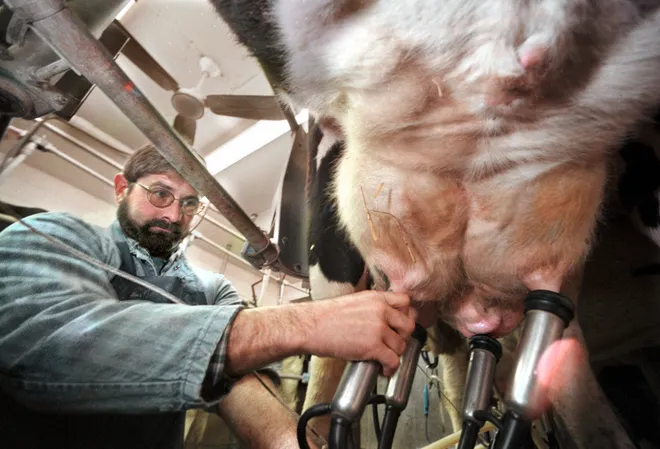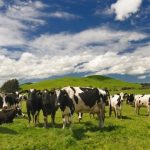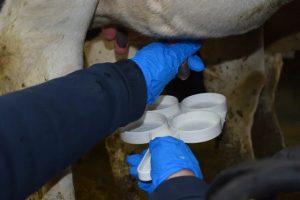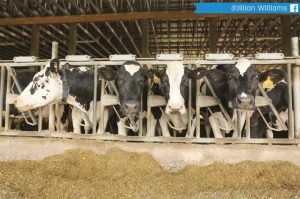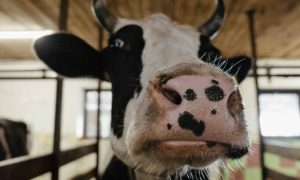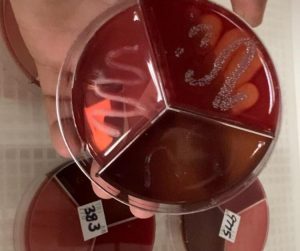
Research shows that cows with a first test in her lactation over 200,000 cell count will be open an extra 17 days and will produce 1,000 pounds less milk than her herdmates that didn’t suffer a clinical mastitis infection.
Dairy farmers packed a session in the village of Dane, sponsored by Lodi Veterinary Care to learn about how milk quality affects their milk checks. Dr. Joel Franks, with Zoetis, explained research that looked at 22 herds – a total of 164,422 cows – to examine the costs and effects of clinical mastitis. “Jerseys and crossbreds were taken out of the research so it was apples to apples,” he said.
In the study, cows that showed clinical mastitis produced less milk in heir lactation, on out to 270 days in milk. The lost milk for cows that had clinical mastitis was 1,000 pounds when the mastitis appeared in the first 60 days. The losses also carried into cull rates with cows showing mastitis in the first 60 days having an increased cull rate of 6 percent in those first two months and a 10 percent cull rate by 120 days in milk.
The mastitis-affected cows also stayed open an extra 17 days, Franks noted, and most dairy economists use a multiplier of $3 or $5 per day for those open days.
The study showed that clinical mastitis, which includes symptoms of hard quarters, high SCC with white blood cells predominating in the milk, and sometimes “off” milk is more costly to the farm beyond the milk that has to get dumped in the gutter. The industry has set a cut point of 200,000 SCC in determining clinical mastitis, he noted.
Fifty to 60 percent of all new infections are caused by environmental pathogens, he said; hormonal shifts both at dry-off and at calving also cause a turnover of cells in the udder. “Most infections occur in the dry cow period. Cows should naturally form a keratin plug but unfortunately 20 to 30 percent of cows don’t form that plug. Other risks of mastitis are man-made. What are we doing to take care of our dry cows?” he added.
Farmers should look at their dry cow care and also at their herd’s numbers to determine if they are making any headway. The goal is to have cows with low cell counts when they are dried off; all animals’ cell counts should be studied on their first test after calving. The cell count on the cows’ first lactation will help arrive at a cure risk during their dry cow period.
Franks also discussed sub-clinical mastitis. When cows have sub-clinical mastitis, they also have an 18 percent greater risk of coming down with clinical mastitis within 60 days.
Preventing new infections
Steps to prevent new infections involve giving the dry cows the best environment possible, resolving her underlying infection problems during the dry cow period, using a teat sealant at dry-off to take the place of a keratin plug and consider using an anti-mastitis vaccine. The vaccine stimulates the cow’s immune system to fight off mastitis pathogens.
The vaccine is designed to be given in three doses – one at dry-off, a second dose two to four weeks later and a third dose soon after the cow freshens. After the first dose, Franks said, cows have 10 to 15 percent immunity, after the second dose they have 40 percent immunity and after the third dose they have 60 to 80 percent immunity.
The teat sealant product needs to be used properly and teat hygiene is important at dry-off. Franks said it is part of dry cow management that helps farmers regain lost milk production and keep down their risks of clinical mastitis and reduce risks of mastitis recurring.
He encouraged farmers to aggressively manage SCC. “Producing high energy-corrected milk requires healthy cows.” This kind of management will protect the herd from turnover costs and extra open days, he said.
Dr. Franks worked as a dairy practitioner in Door County, then at a practice at Casco in Kewaunee County and then with Valley Veterinary Clinic in Seymour before taking a job as a technical service vet with Zoetis.
Ultrasound care for calves
Farmers have gotten used to their herd veterinarians checking their cows with ultrasound – looking for pregnancies, the gender of the developing calf and other reproductive conditions within cows. But Dr. Kaylee Anderson, a practitioner with Lodi Veterinary Care, is one of several vets there who use that same ultrasound equipment for calf care.
She explained that calf lung ultrasound is a fairly new service from the clinic to help determine which calves have lung lesions and need to be treated.
Farmers who raise calves understand the symptoms of respiratory illness – cough, increased respiratory rate, nasal discharge. But sometimes, Anderson said, calves have problems in their lungs without their caretakers seeing any of those outward signs. The ultrasound scan can detect lesions in calves’ lungs before any of those overt signs appear, allowing for quicker treatment and potentially better outcomes for the young heifer calves.
She and other vets at the clinic have several farms that they visit on a regular schedule to do calf lung ultrasound, assigning a score to the calves’ lungs. “We can see a calf go from a score of 2 to 3 in just one day,” she said.
Studies done by Dr. Theresa Ollivett at the University of Wisconsin’s School of Veterinary Medicine, have shown that heifers who have suffered with pneumonia as babies can lose as much as 1,155 pounds of potential milk production in their first lactation. Those animals also have lower pregnancy rates at first service by a factor of 62 percent versus 52 percent.
“Calves that aren’t fighting pneumonia can’t put their energy into growing and the longer we wait to treat, the more difficult it is to fully treat and cure that pneumonia,” Anderson said.
Weaning is a stressful time for calves and it is important to wean them with clean lungs, meaning no consolidation, she added.
When she or her colleagues come to a farm to ultrasound calves’ lungs, they can usually scan 30 calves in an hour, depending on how the calves are housed – calf pens versus hutches. While they are examining the calves they will also look for things like umbilical hernias, abscesses, joint infections and scouring calves.
“Ideally we come to a farm every week and give a score to each calf. That also allows us to monitor treatment success and assess the overall prevalence of pneumonia.”
Anderson said it also allows the vets to monitor the success of treatments on farms where calf managers decide to give every calf antibiotics on a routine basis, or investigate poor growth on calves. The information from these visits helps farmers make informed culling decisions.
While on farms for these calf herd health visits, Anderson said they monitor colostrum management, nesting scores (how the calf nests in the bedding it has available), and keep an eye out for other calfhood diseases.
“All of this helps improve the quality of replacement heifers on the farm,” she said. “It offers immediate results to help in decision making.”
While this kind of service helps in calf raising, “it does not magically fix the problems,” she said. Farmers must still pay attention to colostrum and nutrition management. It does come with a cost to pay for the service and additional antibiotic use.
Anderson said they have ten herds that are now using this calf herd health service from the five vets at the practice who are skilled at it. Calves that get scanned are typically in the 14-day to 35-day age range, depending on the farm’s calf population.
